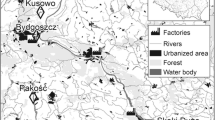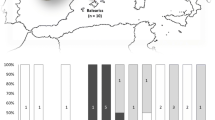Abstract
The concentrations and distribution of metals (Fe, Mn, Zn, Cu, Pb, Ni, Co, As, Hg, and Cd) in an earthworm,Pheretima hilgendorfi, and their variations with growth were investigated. Higher concentrations of the metals were found in the pre-clitellar regions of the earthworm compared with the post-clitellar ones; Cd, Cu, and Hg were relatively high in the gut wall. The body concentration of Pb and Hg decreased with increased body length (age) and weight, while the opposite was found for Cd and As. The accumulation of Fe, Mn, Zn, Cu, Ni, and Co in the earthworm depends primarily on the metabolic turnover, whereas the accumulation of Pb, Hg, Cd and As, is dependent upon the age or exposure time. Small earthworms showed faster uptake and excretion rates of Pb and Hg than the large ones, and the biological half-lives of Pb and Hg were relatively short compared with those of Cd and As. The large earthworms exhibited a decrease of Hg in the bodies, probably due to excretion of Hgvia spawning. Based upon these results, the sizes and parts of the earthworm suitable for purposes of research are discussed.
Similar content being viewed by others
References
Andersen C, Laursen J (1982) Distribution of heavy metals inLumbricus terrestris, Aporrectodea longa and A.rosea measured by atomic absorption and X-ray fluorescence spectrometry. Pedobiologia 24:347–356
Arimura S, Iwashita T, Niina Y, Amano H (1980) Effect of earthworm on physical and chemical properties of a satsuma mandarin orchard soil (part 1). Earthworm populations, micromorphological and chemical properties of earthworm casts. J Sci Soil Manure Jpn 51:8–14
Beyer WN, Chaney RL, Mulhern BM (1982) Heavy metal concentrations in earthworms from soil amended with sewage sludge. J Environ Qual 11:381–385
Darwin C (1881) The formation of vegetable mould through the action of worms. Translated by Shibuya K in 1979, Tatara Shobo, Tottori, 185 pp
Gish CD, Christensen RE (1973) Cadmium, nickel, lead, and zinc in earthworms from roadside soil. Environ Sci Technol 7:1061–1062
Hartenstein R (1982) Metabolic parameters of the earthwormEisenia foetida in relation to temperature. Biotechnol Bioeng 24:1803–1811
Hartenstein R, Neuhauser EF, Collier J (1980) Accumulation of heavy metals in the earthwormEisenia foetida. J Environ Qual 9:23–26
Honda K, Tatsukawa R, Fujiyama T (1982) Distribution characteristics of heavy metals in the organs and tissues of striped dolphin,Stenella coeruleoalba. Agric Biol Chem 46:3011–3021
Honda K, Tatsukawa R, Itano K, Miyazaki N, Fujiyama T (1983) Heavy metal concentrations in muscle, liver and kidney tissues of striped dolphin,Stenella coeruleoalba, and their variations with body length, weight, age and sex. Agric Biol Chem 47:1219–1228
Ireland MP, Richards KS (1981) Metal content, after exposure to cadmium, of two species of earthworm of known differing calcium metabolic activity. Environ Pollut Ser A 26:69–78
Matsumoto S, Tsuge T (1977) Studies on the cast and earthworms. J Sci Soil Manure Jpn 48:142–144
Miyasaka M (1961) Soil animals and soil -on the earthworm-. Pedologist 5:32–38
Mori T, Okada M (1978) Investigation on the possibility of sewage sludge treatment by earth worms (I) -Harvesting earth worms grown in the compost made of sewage sludgeJpn J Water Pollut Res 1:127–132
Nakai M (1975) Treatment of organic waste by earthworms. J Environ Pollut Cont 11:691–694
Nakamura Y (1980) Earthworms and soil-forming process. Pedologist 24:43–50
Phillips DJH (1980) Quantitative aquatic biological indicators. Applied Science Publishers Ltd, London, 448 pp
Shibuya M, Koyama I, Watanabe H (1978) Analytical methods of heavy metals. Hakuyussha, Tokyo, 331 pp
Suzuki KT, Yamamura M, Mori T (1980) Cadmium-binding proteins induced in the earthworm. Arch Environ Contam Toxicol 9:415–424
Tarradellas J, Diercxsens P (1982) Methods of extraction and analysis of PCBs from earthworms. Intern J Environ Anal Chem 13:55–67
Wade SE, Bache CA, Lisk DJ (1982) Cadmium accumulation by earthworms inhabiting municipal sludge-amended soil. Bull Environ Contam Toxicol 28:557–560
Yadav DV, Pillai MKK, Agarwal HC (1976) Uptake and metabolism of DDT and lindane by the earthworm,Pheretima posthuma. Bull Environ Contam Toxicol 16:541–545
Yamagata N (1978) Bioaccumulation. Sangyo Tosho, Tokyo, 288 PP
Yamaguchi E (1970) Story of earthworms. Hokuryukan, Tokyo, 194 pp
Yamamura M, Mori T, Suzuki KT (1981) Metallothionein induced in the earthworm. Experientia 37:1187–1189
Author information
Authors and Affiliations
Rights and permissions
About this article
Cite this article
Honda, K., Nasu, T. & Tatsukawa, R. Metal distribution in the earthworm,Pheretima hilgendorfi, and their variations with growth. Arch. Environ. Contam. Toxicol. 13, 427–432 (1984). https://doi.org/10.1007/BF01056258
Received:
Revised:
Issue Date:
DOI: https://doi.org/10.1007/BF01056258




